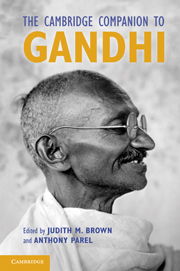11 - Gandhi in independent India
from Part III. - The contemporary Gandhi
Published online by Cambridge University Press: 28 May 2011
Summary
The attainment of independence was no ordinary turning point in Indian history. It marked, according to Nehru’s celebrated ‘Tryst with Destiny’ speech of 15 August 1947, the end of an age and the beginning of a new one. Gandhi, more than any other Indian, had contributed to this transition. His contributions were made during the pre-independent period (he lived only for six months into independence). They had their sources in his struggle against colonial rule and in his deeply cherished aspirations for the future of his country.
There are two ways of looking at Gandhi’s contributions to independent India. One is to look at them as norms by which to evaluate India’s fortunes over the last six decades. The other is to use the fortunes of independent India to test the empirical viability of his contributions. Both approaches are relevant to the present discussion.
Of the numerous contributions that he has made to India, the following are the more significant. First, there is his idea of India as an inclusive nation – ek-praja (‘one-nation’) as he called it. Second, there is his scheme of building a nonviolent social order in a country rent for centuries by violence originating in caste, gender, and religious differences. Third, there is his approach to solving the problem of India’s chronic poverty and his doubts about the suitability of the nineteenth-century type of industrialization.
- Type
- Chapter
- Information
- The Cambridge Companion to Gandhi , pp. 219 - 238Publisher: Cambridge University PressPrint publication year: 2011

